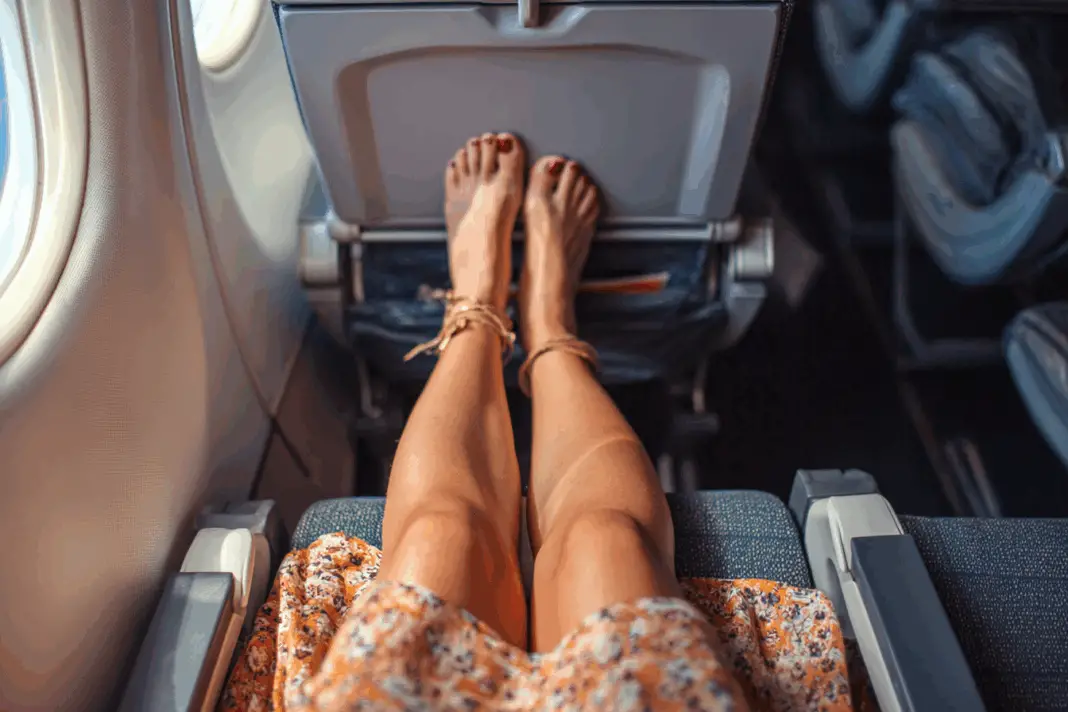Picture settling into your airplane seat, ready for a long flight, and immediately slipping off your shoes to get comfortable. It seems harmless enough, right? What many travelers don’t realize is that this simple act could actually get them kicked off their flight. Major airlines have specific policies about passengers going barefoot, and flight attendants have the authority to enforce these rules. Understanding these regulations could save you from an embarrassing situation at 30,000 feet.
Major airlines explicitly ban barefoot passengers
The three biggest airlines in America have clear rules against passengers going barefoot during flights. American Airlines states in their contract of carriage that passengers must “dress appropriately,” specifically noting that “bare feet or offensive clothing aren’t allowed.” This isn’t just a suggestion – it’s an enforceable rule that could result in removal from the aircraft. Delta takes an equally firm stance, warning that they may refuse transport “when the passenger is barefoot.”
United Airlines goes even further with their policy enforcement. Their contract states that passengers “who are barefoot, not properly clothed or whose clothing is lewd” can be removed mid-flight. This means that even if you board the plane wearing shoes, taking them off during the flight could technically violate their rules. The language used by these airlines shows they take this policy seriously, even though enforcement varies depending on the flight crew and circumstances.
Age restrictions make the rules even more complex
Some airlines apply different standards based on passenger age, creating additional layers of complexity to these policies. Southwest Airlines specifically mentions that staff may remove passengers if they are barefoot and above the age of 5, unless they have a disability that requires them to be barefoot. This age-based distinction suggests that airlines recognize young children might need different accommodations, but expect adults to maintain proper footwear throughout their journey.
JetBlue Airways follows a similar age-based approach in their carriage contract. However, not all airlines worldwide maintain these restrictions. Foreign carriers like Air Canada, Air France, and British Airways don’t have explicit barefoot bans listed in their contracts of carriage. This creates confusion for international travelers who might be accustomed to different standards depending on which airline they typically use for their flights.
Enforcement depends entirely on flight attendant discretion
The reality of these barefoot policies is that enforcement varies dramatically from flight to flight. Most airline contracts use phrases like “may be required” rather than absolute mandates, giving flight attendants considerable discretion in how they handle these situations. This means that one flight attendant might ignore passengers who slip off their shoes, while another might strictly enforce the policy and ask passengers to put their footwear back on immediately.
The inconsistent enforcement creates a confusing situation for travelers who might get away with being barefoot on one flight but face consequences on another. Enforcement is rare, but when it does happen, passengers can face anything from a polite request to put shoes back on to more serious consequences. Understanding that this discretion exists helps explain why some people have never encountered problems while others have faced strict enforcement of these policies.
Safety concerns drive these strict policies
Airlines don’t create barefoot policies just to be difficult – legitimate safety concerns drive these regulations. During emergency evacuations, passengers need to move quickly across potentially dangerous surfaces, including broken glass, metal debris, or rough tarmac. Bare feet would leave passengers vulnerable to serious injuries that could slow down evacuation procedures and put everyone at risk. Flight attendants are trained to think about worst-case scenarios, and proper footwear is considered essential safety equipment.
The safety argument extends beyond emergency situations to everyday flight operations. Airplane aisles can have unexpected spills, rough carpet edges, or small objects that could cause cuts or injuries to bare feet. Safety concerns also include the ability to move quickly to restrooms or other areas of the plane without risk of slipping or stepping on something harmful. These practical considerations influence airline policies more than simple etiquette rules, making the restrictions more about passenger protection than comfort preferences.
Airplane bathrooms present serious hygiene risks
The most compelling reason to keep shoes on during flights involves the condition of airplane restrooms. These small spaces see heavy use from hundreds of passengers, and the liquid on bathroom floors is rarely just water. Cleaning between flights is limited, and turbulence can cause spills that create unsanitary conditions throughout the journey. Walking barefoot into these areas exposes feet to bacteria, germs, and unpleasant substances that could cause infections or other health problems.
Even airplane carpets throughout the cabin aren’t much cleaner than bathroom floors. Travel experts compare walking barefoot on airplane carpets to walking on public streets in terms of cleanliness and hygiene. Food spills, drink accidents, and general wear from thousands of passengers create conditions that make bare feet contact inadvisable. The confined space of an airplane means that cleaning is often superficial, leaving carpets and floors with accumulated grime that isn’t visible to passengers but presents real hygiene concerns.
Fellow passengers find barefoot behavior offensive
Social media regularly features complaints about passengers who remove shoes and socks during flights, with many travelers finding this behavior disrespectful and unpleasant. The confined space of an airplane means that one person’s comfort choices directly impact everyone around them. Foot odors can become particularly problematic in recycled cabin air, and the sight of bare feet can make other passengers uncomfortable, especially when those feet end up near their seats or belongings.
Etiquette experts consistently advise against going barefoot in public spaces, and airplanes definitely qualify as public transportation. Etiquette specialist Jacqueline Whitmore explains that walking barefoot in public places is considered rude and can negatively impact other passengers’ flying experiences. The close quarters and shared space of commercial flights make considerate behavior more important than in other public settings, where people have more room to avoid uncomfortable situations.
Premium cabin passengers get different treatment
First class and business class passengers often receive more flexibility when it comes to footwear policies, particularly in suites with doors that provide privacy. These premium accommodations allow passengers to remove shoes without affecting other travelers, and airlines may provide slippers specifically for use during the flight. The enclosed nature of luxury suites means that foot odors and the sight of bare feet don’t impact other passengers, making enforcement of barefoot policies less necessary.
However, even premium passengers are expected to wear appropriate footwear when moving through common areas of the aircraft. Airlines often provide slippers for premium passengers to use when walking to lavatories or other areas outside their seats. This accommodation recognizes the desire for comfort during long flights while maintaining hygiene and safety standards throughout the aircraft. The key difference is that premium passengers have options and accommodations that aren’t available to economy travelers.
Smart alternatives keep feet comfortable legally
Travelers who want foot comfort without violating airline policies have several practical options. Wearing clean socks after removing shoes provides comfort while maintaining coverage that satisfies most airline requirements. Bringing comfortable slippers or slide-on shoes makes it easy to slip footwear back on when walking around the cabin. Many frequent travelers pack compression socks that provide comfort during long flights while meeting airline dress code requirements.
Another strategy involves choosing appropriate footwear before the flight begins. Loose-fitting shoes, comfortable loafers, or slip-on styles provide easier removal and replacement while maintaining compliance with airline policies. Covering feet with blankets while resting can provide additional comfort and discretion for passengers who remove shoes during flight. These simple accommodations allow travelers to stay comfortable without risking confrontation with flight attendants or fellow passengers who might object to bare feet.
Airlines take barefoot policies seriously enough to include them in official contracts, even if enforcement isn’t always consistent. The combination of safety requirements, hygiene concerns, and passenger comfort considerations makes keeping shoes on during flights the smart choice for avoiding potential problems. Next time you fly, pack comfortable socks or slippers instead of planning to go barefoot – your fellow passengers and the flight crew will appreciate your consideration.

